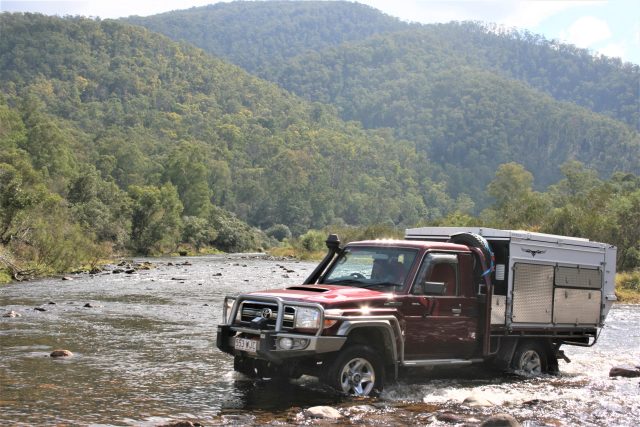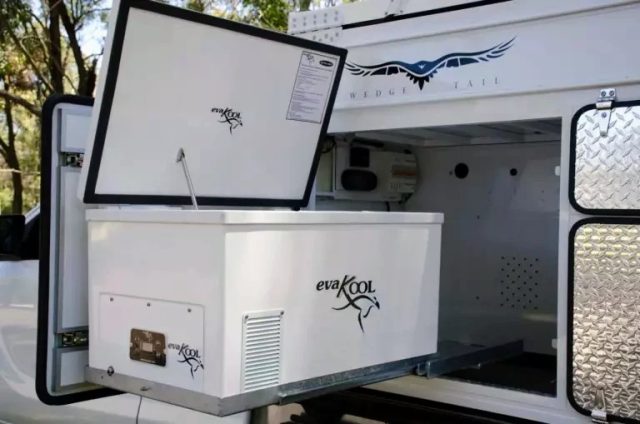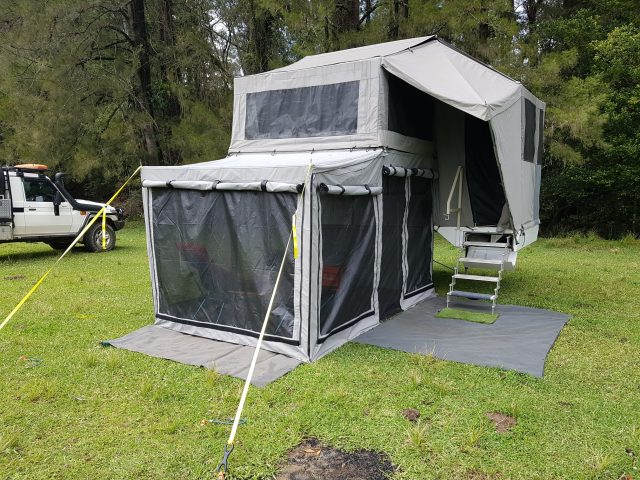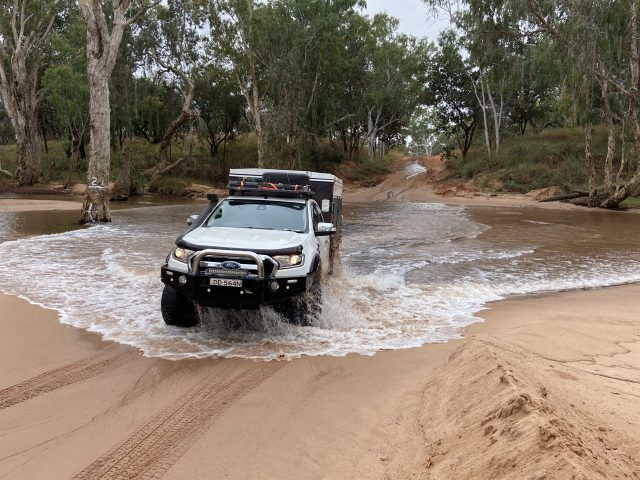With time and experience, we all eventually develop a style of travel and preference for a vehicle that suits that style of travel best. What suits me as a full-time, 4WD-experienced international traveler with a family and pets will not necessarily appeal to an active and adventurous young couple who road trip and run trails occasionally, or a retired couple happily exploring the nooks and crannies of their own country for months at a time. To state the obvious, there is no one-size-fits-all overland vehicle, and some are more niche than others.

Wedgetail, the award-winning camper manufacturer, has headquarters north of Sydney, Australia and manufactures the fully customizable and lightweight Wedgetail 22 slide-on camper (approximately 900 lbs empty) that is designed for harsh Australian conditions and backed by a 12-year structural warranty that includes free routine maintenance!
The Wedgetail 22 is based on a sturdy, heavy-duty, purpose-built flatbed that features storage boxes and a recess for the storage of four recovery boards and a spade, as well as the gray water tank. The departure angle of the flatbed is excellent; a tow hitch is incorporated into the frame above, which also houses the brake and reverse lights. The spare tire remains underslung. The camper box can be removed from the flatbed, which may be an important and attractive feature for those who intend to use the vehicle and flatbed for other purposes, whether storing the camper or setting it up as a base camp from which to explore the surrounding areas. Before deployment, the camper is only slightly wider than the body of a standard pickup most commonly seen in Australia, e.g. the Toyota Hilux, and the height is no higher than an intelligently packed roof rack. At close to 7-foot closed and 11-foot open, the length of the camper is not extreme, which makes it a great option for those who often explore tight off-road trails. The fuel filler is incorporated into the flatbed and has been engineered to accept a high fuel flow rate with a minimal back surge.

Exterior compartments
The camper itself is quite unique. The utility side of the camper offers exterior access to infrastructure, including a lockable water filler (which fills a 90-liter fresh water tank), space heater vent, main water pressure inlet, gray water drain connection for the sink and shower, a 240-volt hook up and a hot water system which runs off gas, 240-volt or both. Most of the built-in storage boxes (seven, to be precise) are accessible from both the exterior and interior of the camper; this convenient solution is sure to reduce much of the frustration of gear access. Four hatches provide individual access to two four-kilogram LPG tanks (which, when used conservatively, should last quite some time), a general storage box, and a clothing/gear storage compartment. The rear compartment is the largest, and it stores the outside shower head and hose and the removable cassette toilet. It is worth noting that high-mass items such as water tanks, gas tanks, and battery packs are located low at the front of the camper to ensure optimal weight distribution.
The kitchen side of the camper features three large storage boxes, all of which can be accessed from both the interior and exterior. The forward compartment houses a cavernous 80-liter fridge and freezer (the Australian outback is vast, sufficient supplies are essential), which is mounted on a sophisticated lockable, sliding swing arm tray. The camper stands, which support the camper when removed from the flatbed, are stored beneath the fridge. The forward wall of the fridge compartment is equipped with the 240-volt and 12-volt system, the battery charger and monitor, hot water controls, and water level monitor.A truly trick feature on this camper is an air inlet and filter that pressurizes the cabin as you drive to drain heat from the fridge and to prevent dust ingress. Circuit breakers generally replace fuses throughout the camper—a well-considered upgrade in a camper designed for remote exploration.

The two horizontal rear compartments are equipped with a simple drawer system and containers for the storage of kitchen equipment, food, and condiments, all of which are held in place by elasticated cords. An optional stainless steel barbecue, originally designed for a boat’s transom, slides and swings out from the lower compartment. The barbecue is a practical and attractive unit that can be used for conventional grilling, as a stove, and even as an oven for making bread or roasting a small kangaroo (a conventional cooker is also an option). Above the barbecue are hot and cold water faucets, a gas supply for the barbecue, and 12-volt power outlets. If you or your companion are vertically challenged or have a lifted vehicle with tall tires, you may want to pack a stool, as the fridge lid and upper kitchen drawers may be beyond comfortable reach.
Solar power
The camper’s roof houses a 200-watt solar panel controlled via a battery management system to regulate the charge from the vehicle and the solar panel to the house battery. With the camper and tent deployed, the solar panel may need to be removed and relocated to an optimal position beside the vehicle to continue providing a charge, especially if you are camping in one place for a few days or more. Two support poles are secured on the roof and may need additional strapping when driving tight trails with low-hanging branches.
Storage compartments
A large box split into two compartments dominates the rear of the camper: one half contains the tent poles and staircase handrail and will likely store your camp furniture, hoses, and sundries, while the second, smaller compartment neatly secures and protects the folding staircase. This box folds open from the main body of the camper and is the base of the entrance and bathroom.
The camper’s exterior is user-friendly and convenient for daily tasks while on the trail, providing access to accessories, equipment, clothing, and the kitchen area without needing to open the camper entirely.

Setting up camp
Setting up camp is not a push-button affair and can be done by one person, though an extra set of helpful hands could significantly reduce set-up time.
Once the tent poles and handrail are removed from the rear compartment, two latches are unlocked, the compartment is lowered via a hand crank; the stairs are then deployed, and the handrail is installed. Two latches are then unlocked on the utility side of the camper, the roof is opened via a secondhand crank, and the roof becomes a convenient awning. Two base plates are then retrieved and placed at either end of the roof/awning/bed base, and two integrated support poles are released, extended, and pinned with clevis pins. What follows is a similar process to erecting a large canvas tent with a number of fixed (four) and loose (four) poles being installed inside the tent, above the bed, and within the bathroom to provide taut walls and access to the queen size bed, dinette, and bathroom.
Outside, an entrance awning must be set up with a set of extending poles, and then the canvas must be secured before two more poles are extended and affixed to the utility side window awning. The solar panel must be removed and deployed if you intend to camp in one area for a few days (as mentioned before); camping chairs and a table can then be arranged in the shade, and a much-deserved cold drink can be consumed. While the bed platform does not offer much shade, an additional awning with walls is available. The Wedgetail designers have thought of everything, it seems. In total, the time and energy spent to set up the camper would be roughly equivalent to opening a couple of old-school canvas rooftop tents and an awning. Pack-up usually takes longer than a set-up for some reason, but eventually the process should become second nature with time and practice.

Interior space
This brings us to the spacious, well-ventilated interior. The queen size bed is enveloped when packed in a strapped canvas shell that protects the mattress and bedding and secures it when the camper is closed (the bed flips over as the base is the roof). Three large windows feed the sleeping area with light and air, and two reading lamps and a base for an air cooler or fan bring a touch of luxury to bedtime. Every wall features a large window. You will not forget that you are camping in the great outdoors, a huge selling point for many. The bathroom is roomy and private, adjacent to the doorway, and boasts a shower and cassette toilet. 90 liters is a fair amount of water storage, but it may be wise to either increase the size of the water tank or invest in a pump and filtration system for the sourcing and treatment from natural water sources.
The Wedgetail 22 also features an interior cooker and sink, which, along with access to the fridge and kitchen cupboards, allow for the preparation of meals within the camper when the weather turns or bugs attack; a heater will keep you warm when the desert night temperatures plunge.
The Wedgetail 22 has grown on me the longer I look at it. Yes, setting up and packing up takes a reasonable amount of time and energy, and a large amount of canvas could be problematic in extremely windy conditions, but some great features can’t be ignored.
I believe that this camper, as it is, is perfect for a nature-loving couple who enjoys the romance and nostalgia of canvas tents and an elevated fishbowl view of their surroundings. This couple will likely travel long distances on challenging roads to beautiful places where they will set up camp for days, even weeks, while enjoying the outdoors. Paired with the right vehicle, this camper allows great mobility and off-road agility. The Wedgetail 22 is a surf fisherman’s dream come true.
From $35,000
Our No Compromise Clause: We carefully screen all contributors to ensure they are independent and impartial. We never have and never will accept advertorial, and we do not allow advertising to influence our product or destination reviews.


